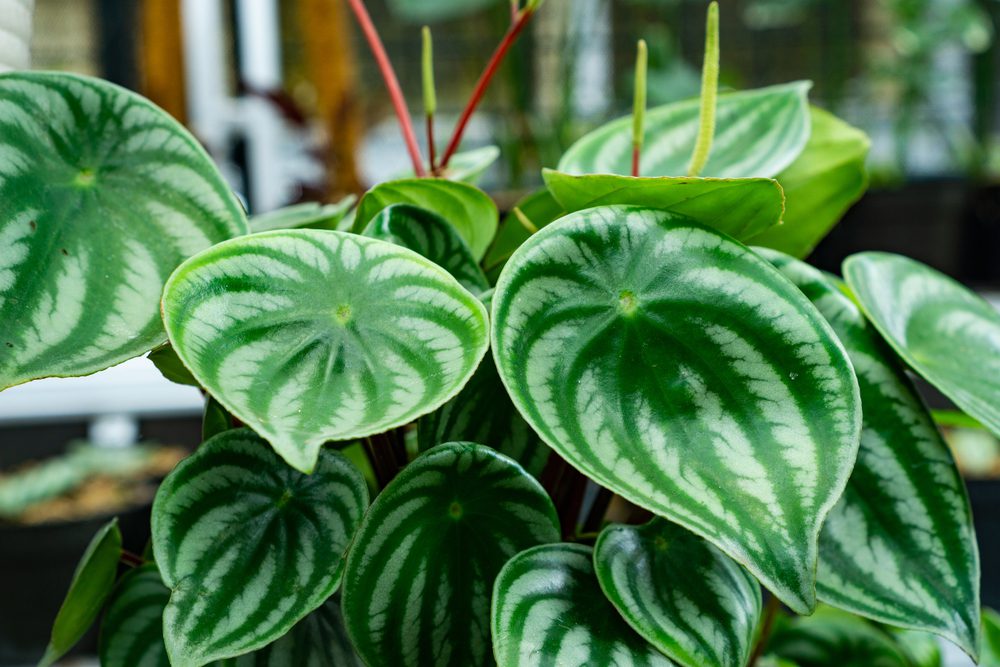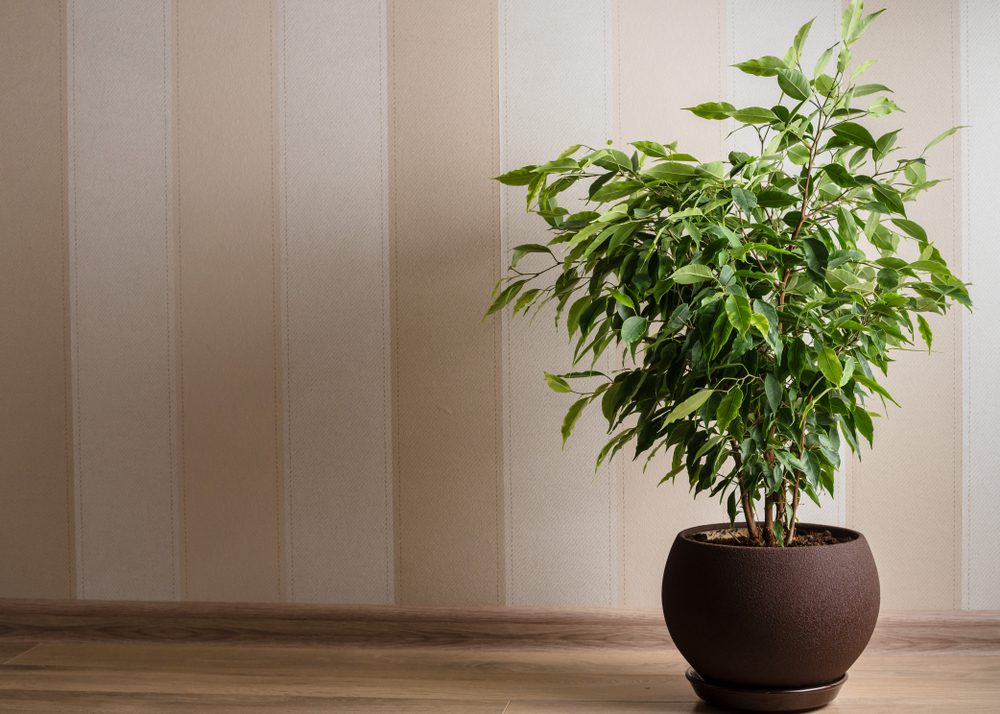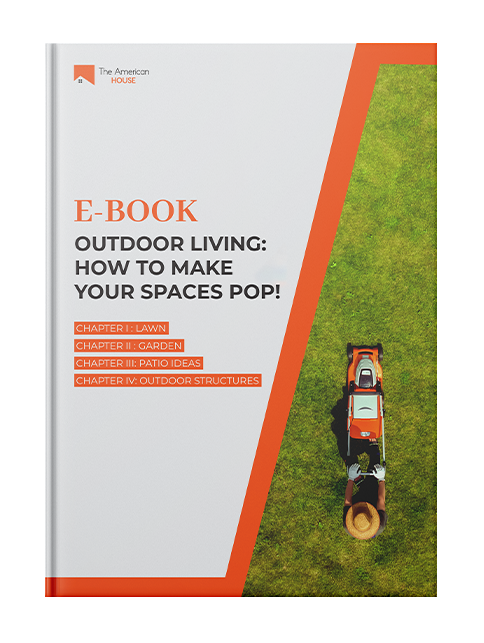Perhaps you’ve previously had an indoor plant that suddenly turned into a yellowing, wilting embarrassment. Or, maybe you’ve never had a houseplant because you’re unsure if you’ll be able to keep it alive.
But don’t get discouraged! Finding the best low-maintenance houseplants is the first step towards success with plants. Maybe you just need a houseplant that doesn’t need to be watered every two days. Or an indoor plant that can survive a week alone while you’re out of town for a friend’s wedding.
Here are the 10 best low-maintenance houseplants that are pretty hard to kill! Not only will they add color and lushness to your home, but you won’t have to worry too much about taking care of them. Enjoy!

1. Peperomia
- Scientific name: Peperomia ssp.
- Growing Conditions: Low, but also medium light; allow the soil to dry between waterings; 60-75 degrees Fahrenheit
- Size: Up to 1 foot wide and tall
- Note: This houseplant is poisonous if chewed or eaten by cats or dogs.
Peperomias are a wide group of small, low-maintenance houseplants that have waxy and highly textured leaves. Watermelon peperomia, ripple peperomia, Silverleaf peperomia, and baby rubber plan are some of the most popular varieties (and our favorites too).
If you’re looking for a low-maintenance houseplant that also adds a splash of color to your room, then Peperomia is your way to go! Its colorful, waxy foliage will definitely be a great addition without taking up too much space.
2. Norfolk Island Pine
- Scientific Name: Araucaria heterophylla
- Growing Conditions: Bright light; let the soil surface dry before watering again; 60-75 degrees Fahrenheit
- Size: Up to 5 feet wide and 10 feet tall
A new tree can be quite expensive if you want to have it outdoors. Indoor trees, however, are affordable yet eye-catching houseplants for budding gardeners. The key to keeping this low-maintenance houseplant healthy indoors is to provide it with indirect but bright light. In low light, its lower branches become brown and fall off. The Norfolk Island pine’s soft texture adds a woodsy, cozy feeling to any room. It’s especially adorable when decorated for Christmas.
3. English Ivy
- Scientific Name: Hedera helix
- Growing Conditions: Medium but also bright light; keep evenly moist; 55-70 degrees Fahrenheit
- Size: Trails or climbs to 6 feet (sometimes even more)
- Note: This plant is poisonous if chewed or eaten.
English Ivy has vigorous vining stems and leathery leaves that have made it attractive and popular as a low-maintenance outdoor groundcover. Unfortunately, it has turned invasive, spreading harmfully in some regions. It can also be a low-maintenance houseplant, which means you can keep it contained and put it somewhere in your house.
It works best in indirect yet bright light, although it will also work well in low light. It does best wherever a draping plant is needed and you can simply get your English Ivy to climb if a more upright look is desired.
4. Rubber Tree
- Scientific Name: Ficus elastica
- Growing Conditions: Medium to bright light; let the soil surface dry before watering again; 60-80 degrees Fahrenheit
- Size: Up to 4 feet wide and 8 feet tall
- Note: Its milky white sap can cause irritation to those who have sensitive skin
The rubber tree, a popular and classic houseplant, gets its name from the milky, sticky sap leaking from cuts. Although it can turn into a large tree, you can simply keep it shorter by trimming those long stems, forcing it to branch and spread into a shrub with multiple stems.
This low-maintenance houseplant has large, dark green, glossy leaves that always stand out, especially on a large plant. With or without a green thumb, this plant is very hard to kill, and you’ll only have to water it every 1-2 weeks.

5. ZZ Plant
- Scientific name: Zamioculcas zamiifolia
- Growing Conditions: Low, medium, and bright light; allow the soil to dry before watering again; 60-75 degrees Fahrenheit
- Size: About 2-3 feet wide and tall
- Note: This houseplant is poisonous if chewed or eaten.
ZZ plant, also known as eternity plant because of its long life cycle, can grow in low light and may survive weeks without water. Aside from the fun nickname, you’ll love this low-maintenance houseplant for its softly arching stems that are lined on either side with dark green, smooth leaves. Its thick leaves and stems are so sturdy that you may mistake them for plastic. For those who want to add a moody look, there is a variety called ‘Raven’, which has almost black leaves.
6. Jade Plant
- Scientific Name: Crassula ovata
- Growing Conditions: Bright light; keep moderately dry; 65-75 degrees Fahrenheit, 55 degrees Fahrenheit in winter
- Size: Up to 3 feet tall wide and 5 feet tall
If remembering to water your plants is a struggle, this low-maintenance houseplant may be precisely what you need. This slow-growing plant can go for weeks (sometimes even months) without water. This can happen because this plant stores the water it needs in its leaves and fleshy stems.
So if you can grow a cactus, you can definitely keep a jade plant alive. When grown near other types of succulents with squat shapes, the jade plant’s stems branch like a mini tree or shrub, adding an interesting contrast.
7. Spider Plant
- Scientific Name: Chlorophytum comosum ‘Vittatum’
- Growing Conditions: Medium but also bright light; the soil must be evenly moist; 60-75 degrees Fahrenheit
- Size: Up to 2 feet wide and 1 foot tall
You must have heard about this one, and you surely have seen it somewhere. In fact, spider plants are one of the most commonly known indoor plants. They have been decorating our houses for decades, and it’s simple to see why.
This low-maintenance houseplant has long, narrow leaves with a jaunty, spidery look. When spider plants reach a certain size, they start making baby plants that can be seen on the ends of long stems. These young plants are easy to root in other pots. Some varieties have plain green leaves, but there are also variegated varieties that have white or cream stripes.
8. Cast-Iron Plant
- Scientific name: Aspidistra elatior
- Growing Conditions: Low light; keep barely moist in winter and fall, evenly moist during active growth; 45-85 degrees Fahrenheit
- Size: Up to 2 feet wide and tall
Here’s one low-maintenance houseplant that can clearly win any best impossible-to-kill plants contest! The cast-iron plant definitely lives up to its common name: it seems to be able to withstand almost any condition. It is tolerant to neglect and can survive in low humidity, low light, and in a broad range of temperatures.
As this low-maintenance houseplant grows slowly, you can choose a larger plant to fill the space if it’s necessary. There are also other varieties that have yellow or white variegation on their leaves.

9. Weeping Fig
- Scientific Name: Ficus benjamina
- Growing Conditions: Bright indirect light; keep the plant away from cold drafts; let the soil dry out before watering again; 60-75 degrees Fahrenheit
- Size: 5-15 feet tall indoors
Weeping fig, the interior designer’s longtime darling, is a low-maintenance houseplant that produces lots of bright green, teardrop-shaped leaves on slender branches. There are braided varieties as well, which feature three or even more small trees woven together to create one stunning trunk. Since this indoor plant isn’t fussy about humidity and water, you won’t have to worry too much about watering it.
Here’s a pretty flower pot where you can grow your weeping fig.
10. Dieffenbachia
- Scientific Name: Dieffenbachia spp
- Growing Conditions: Low and medium light; keep evenly moist; 60-80 degrees Fahrenheit
- Size: Up to 3 feet wide and 6 feet tall
- Note: This plant is poisonous and may cause severe inflammation of the tongue, lips, and throat if chewed and eaten.
Dieffenbachia refers to several closely related species that all have cane-like stems and beautiful green foliage variegated in cream or white. Its large, white-and-green leaves provide a tropical vibe to any room you choose to have the plant. This low-maintenance houseplant also has a common name — dumb cane —that relates to the effect of the plant if eaten.
Do you want to decorate your garden? Here are 10 Gorgeous Flowers That Bloom All Year Round!





